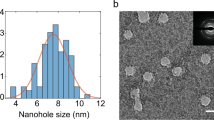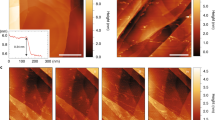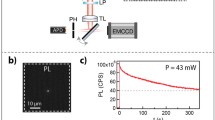Abstract
Drilling precise nanopores in thin layers is in rapid demand for biosensing applications. We demonstrate that an energetic multi-wall carbon nanotube (MWCNT) can be a good candidate to fabricate nanopores on graphene from molecular dynamics simulations with a bond-order potential. High-quality nanopores with expected size and smooth margins could be created by an incident nanotube at chosen size and energy. Besides, a nanotube is in advantage of absorbing and translocating many biological macromolecules due to its strong adsorption capacity. It implies a feasible way to drill nanopores and carry big molecules through the fabricated nanopores in one step for fast biosensing applications.





Similar content being viewed by others
Data availability
All data are available on reasonable request to the corresponding author.
References
Venkatesan B, Bashir R (2011) Nanopore sensors for nucleic acid analysis. Nat Nanotech 6:615–624. https://doi.org/10.1038/nnano.2011.129
Fried JP, Swett JL, Nadappuram BP, et al. (2021) In situ solid-state nanopore fabrication. Chem Soc Rev 10:1039. https://doi.org/10.1039/D0CS00924E
Bell N, Keyser U (2016) Digitally encoded DNA nanostructures for multiplexed, single-molecule protein sensing with nanopores. Nat Nanotech 11:645–651. https://doi.org/10.1038/nnano.2016.50
Kasianowicz JJ, Brandin E, Branton D, Deamer DW (1996) Characterization of individual polynucleotide molecules using a membrane channel. Proc Natl Acad Sci USA 93:13770
Dekker C (2007) Solid-state nanopores. Nat Nanotech 2:209–215. https://doi.org/10.1038/nnano.2007.27
Plesa C, Kowalczyk SW, Zinsmeester R, Grosberg AY, Rabin Y, Dekker C (2013) Fast translocation of proteins through solid state nanopores. Nano Lett 13:658–63. https://doi.org/10.1021/nl3042678
Squires A, Atas E, Meller A (2015) Nanopore sensing of individual transcription factors bound to DNA. Sci Rep 5:11643. https://doi.org/10.1038/srep11643
Singer A, Wanunu M, Morrison W, et al. (2010) Nanopore based sequence specific detection of duplex DNA for genomic profiling. Nano Lett 10:738–742. https://doi.org/10.1021/nl100058y
Heerema SJ, Vicarelli L, Pud S, Schouten RN, Zandbergen HW, Dekker C (2018) Probing DNA translocations with inplane current signals in a graphene nanoribbon with a nanopore. ACS Nano 12:2623–2633. https://doi.org/10.1021/acsnano.7b08635
Danda G, Masih Das P, Chou YC, Mlack JT, Parkin WM, Naylor CH, Fujisawa K, Zhang T, Fulton LB, Terrones M, Johnson AT, Drndic M (2017) Monolayer WS2 nanopores for DNA translocation with light-adjustable sizes. ACS Nano 11:1937–1945. https://doi.org/10.1021/acsnano.6b08028
Liu K, Feng J, Kis A, Radenovic A (2014) Atomically thin molybdenum disulfide nanopores with high sensitivity for DNA translocation. ACS Nano 8:2504–2511. https://doi.org/10.1021/nn406102h
Schneider GF, Kowalczyk SW, Calado VE, et al. (2010) DNA translocation through graphene nanopores. Nano Lett 10:3163–3167. https://doi.org/10.1021/nl102069z
Wang R, Gilboa T, Song J, et al. (2018) Single-molecule discrimination of labeled DNAs and polypeptides using photoluminescent-free TiO2 nanopores. ACS Nano 12:11648–11656. https://doi.org/10.1021/acsnano.8b07055
Xia D, Huynh C, McVey S, Kobler A, Stern L, Yuan Z, Ling XS (2018) Rapid fabrication of solid-state nanopores with high reproducibility over a large area using a helium ion microscope. Nanoscale 10:5198. https://doi.org/10.1039/C7NR08406D
Kim MJ, Wanunu M, Bell DC, Meller A (2006) Rapid fabrication of uniformly sized nanopores and nanopore arrays for parallel DNA analysis. Adv Mater 18:3149–3153
Novoselov KS, Geim AK, Morozov SV, Jiang D, Zhang Y, Dubonos SV, Grigorieva IV, Firsov AA (2004) Electric field effect in atomically thin carbon films. Science 306:666–9. https://doi.org/10.1126/science.1102896
Herbig C, Michely T (2016) Graphene: the ultimately thin sputtering shield. 2D Mater 3:025032. https://doi.org/10.1088/2053-1583/3/2/025032
Fischbein MD, Drndi M (2008) Electron beam nanosculpting of suspended graphene sheets. Appl Phys Lett 93:113107. https://doi.org/10.1063/1.2980518
Storm AJ, Chen JH, Ling XS, et al. (2003) Fabrication of solid-state nanopores with single-nanometre precision. Nat Mater 2:537–540. https://doi.org/10.1038/nmat941
Watanabe K, Taniguchi T, Kanda H (2004) Direct-bandgap properties and evidence for ultraviolet lasing of hexagonal boron nitride single crystal. Nat Mater 3:404–409. https://doi.org/10.1038/nmat1134
Zvuloni E, Zrehen A, Gilboa T, Meller A (2021) Fast and deterministic fabrication of sub-5 nanometer solid-state pores by feedback-controlled laser processing. ACS Nano 10:1021. https://doi.org/10.1021/acsnano.1c03773
Gilboa T, Zvuloni E, Zrehen A, Squires AH, Meller A (2019) Automated, ultra-fast laser-drilling of nanometer scale pores and nanopore arrays in aqueous solutions. Adv Funct Mater 19:00642. https://doi.org/10.1002/adfm.201900642
Verschueren DV, Yang W, Dekker C (2018) Lithography-based fabrication of nanopore arrays in freestanding SiN and graphene membranes. Nanotechnology. 29:145302. https://doi.org/10.1088/1361-6528/aaabce
Sawafta F, Clancy B, Carlsen AT, Huber M, Hall AR (2014) Solid-state nanopores and nanopore arrays optimized for optical detection. Nanoscale 6:6991. https://doi.org/10.1039/C4NR00305E
Zhao S, Xue J, Liang L, Wang Y, Yan JS (2012) Drilling nanopores in graphene with clusters: a molecular dynamics. J Phys Chem C 116:11776–11782. https://doi.org/10.1021/jp3023293
Li W, Liang L, Zhao S, Zhang S, Xue J (2013) Fabrication of nanopores in a graphene sheet with heavy ions: a molecular dynamics study. J. Appl. Phys. 114:234304
Lee JH, Loya PE, Lou J, Thomas EL (2014) Dynamic mechanical behavior of multilayer graphene via supersonic projectile penetration. Science 346:1092–1096. https://doi.org/10.1126/science.1258544
Berdiyorov GR, Mortazavi B, Ahzi S, Peeters FM, Khraisheh MK (2016) Effect of straining graphene on nanopore creation using Si cluster bombardment: a reactive atomistic investigation. J Appl Phys 120:225108. https://doi.org/10.1063/1.4971767
Bai Z, Zhang L, Li H, Liu L (2016) Nanopore creation in graphene by ion beam irradiation: geometry, quality, and efficiency. In: Bai Z, Zhang L, Li H, Liu L (eds) Appl Mater Interfaces, vol 8, pp 24803–24809
Verkhoturov SV, Czerwinski B, Verkhoturov DS, Geng S, Delcorte A, Schweikert EA (2017) Ejection-ionization of molecules from free standing graphene. J Chem Phys 146:084308. https://doi.org/10.1063/1.4976832
Geng S, Verkhoturov SV, Eller MJ, Della-Negra S, Schweikert EA (2017) The collision of a hypervelocity massive projectile with free-standing graphene: investigation of secondary ion emission and projectile fragmentation. J Chem Phys. 146:054305. https://doi.org/10.1063/1.4975171
Verkhoturov SV, Gounski M, Verkhoturov DS, Geng S, Postawa Z, Schweikert EA (2018) Trampoline ejection of organic molecules from graphene and graphite via keV cluster ions impacts. J Chem Phys 148:144309. https://doi.org/10.1063/1.5021352
Golunski M, Postawa Z (2018) Effect of kinetic energy and impact angle on carbon ejection from a free-standing graphene bombarded by kilo-electron-volt C60. J Vac Sci Technol B 36:03F112. https://doi.org/10.1116/1.5019732
Abadi R, Shirazi A, Izadifar M, Sepahi M, Rabczuk T (2018) Fabrication of nanopores in polycrystalline boron-nitride nanosheet by using Si, SiC and diamond clusters bombardment. Comp Mater Sci 145:280–290
Verkhoturov SV, Gounski M, Verkhoturov DS et al (2019) Hypervelocity cluster ion impacts on free standing graphene: experiment, theory, and applications. J Chem Phys 150:160901. https://doi.org/10.1063/1.5080606
Popok VN, Campbell EEB (2006) Beams of atomic cluster effect on impact with solids. Rev Adv Mater Sci 11:19–45
Plimpton S (1995) Fast parallel algorithms for short-range molecular dynamics. J Comput Phys 117:1–19. https://doi.org/10.1006/jcph.1995.1039
Zhou XW, Ward DK, Foster ME (2015) An analytical bond-order potential for carbon. J Comput Chem 36:1719–1735. https://doi.org/10.1002/jcc.23949
Berendsen HJC, Postma JPM, Gunsteren WF, DiNola A, Haak JR (1984) Molecular dynamics with coupling to an external bath. J Chem Phys 81:3684. https://doi.org/10.1063/1.448118
Stukowski A (2010) Visualization and analysis of atomistic simulation data with OVITO the open visualization tool. Model Simul Mater Sci Eng 18:015012
Zubieta-Lopez FA et al (2020) Li containing endohedral SWCNT: DFT study of the structural and electronic properties. Diamond Related Mater 110:108108. https://doi.org/10.1016/j.diamond.2020.108108
Rodriguez-Juarez A, Chigo-Anota E, Hernandez-Cocoletzi H, Sanchez-Ramirez JF, Castro M (2017) Stability and electronic properties of armchair boron nitride/carbon nanotubes, fullerenes. Nanotubes and Carbon Nanostructures 25(12):716–725. https://doi.org/10.1080/1536383X.2017.1389905
Garcia-Hernandez E, Chigo-Anota E (2021) Structural defects on (5,5) single-walled carbon nanotubes: impact on their electronic properties and chemical reactivity from a DFT perspective. Phys E 134:114874. https://doi.org/10.1016/j.physe.2021.114874
Sozykin SA, Beskachko VP (2022) The structure and properties of a carbon nanotube (7, 7) with a vacancy defect. Lett Mater 12(1):32–36. https://doi.org/10.22226/2410-3535-2022-1-32-36
Schneider CA, Rasband WS (2012) Eliceiri KW. NIH Image to ImageJ: 25 years of image analysis. Nat Methods 9(7):671–5. https://doi.org/10.1038/nmeth.2089
Funding
This work was financially supported by the Hunan education department under Grant No. 19B386, and the key projects of Hunan education department (No. 20A344).
Author information
Authors and Affiliations
Contributions
C.L.: conceptualization, simulation, validation, visualization, and writing of the manuscript. Z.W.: methodology, validation, and revising. L.M.: simulation, validation, and revising.
Corresponding author
Ethics declarations
Conflict of interest
The authors declare no competing interests.
Additional information
Publisher’s note
Springer Nature remains neutral with regard to jurisdictional claims in published maps and institutional affiliations.
Rights and permissions
Springer Nature or its licensor holds exclusive rights to this article under a publishing agreement with the author(s) or other rightsholder(s); author self-archiving of the accepted manuscript version of this article is solely governed by the terms of such publishing agreement and applicable law.
About this article
Cite this article
Li, C., Wang, Z. & Ma, L. Drilling accurate nanopores for biosensors by energetic multi-wall carbon nanotubes: a molecular dynamics investigation. J Mol Model 28, 304 (2022). https://doi.org/10.1007/s00894-022-05276-8
Received:
Accepted:
Published:
DOI: https://doi.org/10.1007/s00894-022-05276-8




